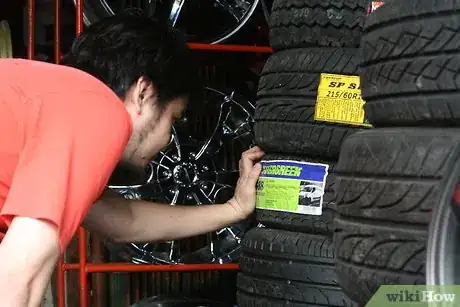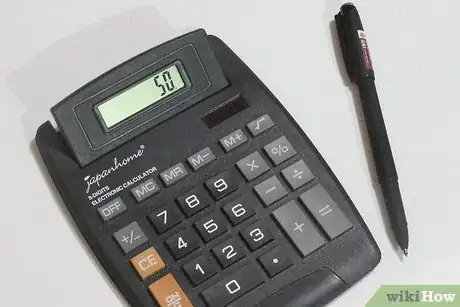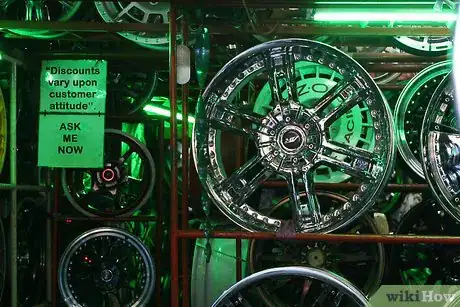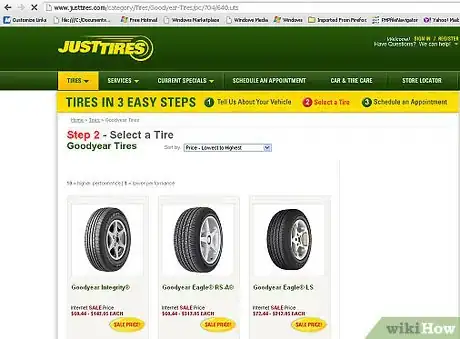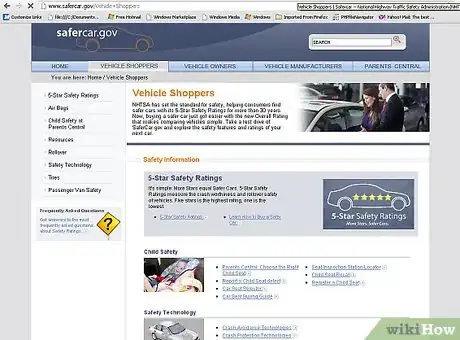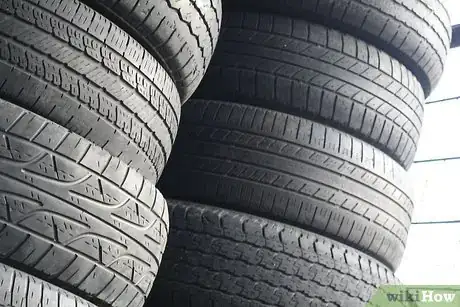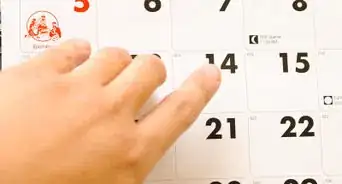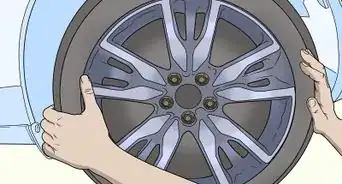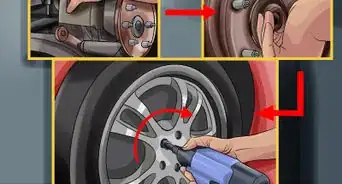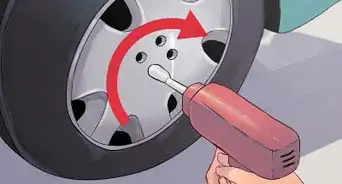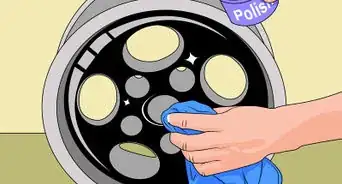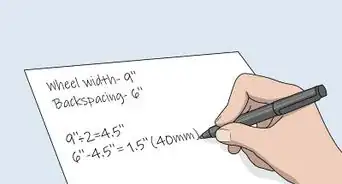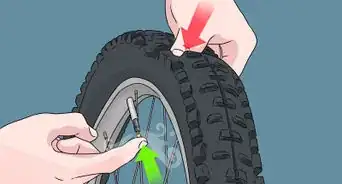wikiHow is a “wiki,” similar to Wikipedia, which means that many of our articles are co-written by multiple authors. To create this article, 27 people, some anonymous, worked to edit and improve it over time.
There are 8 references cited in this article, which can be found at the bottom of the page.
wikiHow marks an article as reader-approved once it receives enough positive feedback. In this case, 93% of readers who voted found the article helpful, earning it our reader-approved status.
This article has been viewed 506,240 times.
Learn more...
Did you know you can haggle when you're buying tires? That's right — you should never have to pay full price. After deciding what brand you want, go to a dealer and put your haggling skills to the test. Make sure you do some online research first, since you'll often find a better deal online than you could get in person. Getting prepared before making a purchase is the best way to ensure you're getting a great deal.
Steps
-
1Decide which brand of tire you want. A specific brand dealer will be able to get you a much better price on the brand his store is owned by, because he gets them direct from the factory. When you try to get a brand different from the one the dealer has, he buys them from a tire wholesaler, and then marks them up 20% to 30%. Many companies have stopped selling direct to dealers and department stores, instead marketing their tires through a larger wholesaler and controlling the price level by having dealers join an alliance program.[1]
- Big-box stores such as Sears and Walmart, and warehouse stores such as Costco and Sam's Club, often have low but probably non-negotiable prices on tires.
-
2Do your homework. Know which tire you want when you walk in. They will be pushing their top-of-the-line tire at the moment because the salespeople get more commission per tire on those.[2]
- Also have a second and even a third choice as a backup to your first choice. You may be able to get a better tire for a lesser price today
Advertisement -
3Try not to accept the first offer. Tires are marked up, and most salespeople will work out the quote with the suggested retail price. This can be anywhere from $5 to $50 over store cost per tire. Make sure the quote includes installation and balance.
-
4Be polite. A common sentiment among salespeople is that "Discounts vary upon customer attitude."
-
5Get quotes from other dealers before stepping into the store. The best way to do this is call and ask for prices on the tires that you have decided to purchase. They will try to sell you another brand that they claim is a better deal (which is sometimes true). Getting quotes from multiple dealers will help you determine when dealers are being honest and when they are simply out for more money.[3]
-
6Always consider buying from an online tire store. You may find a better deal than any brick and mortar store, even after you add shipping charges. This is especially true for less popular brands of tires and/or high-performance tires.[4]
- Online stores will often ship the tires directly to a mechanic of your choice, who will perform the actual installation.
- Online stores such as Tire Rack will often provide numerous reviews of different kinds of tires and ratings of various aspects of their performance such as ride, wet and dry traction, fuel consumption, and longevity.
- TireRack.com will also give you prices for local tire installers (go to the installation section).
- Remember that installation and balancing is an additional cost.
- Any warranty claims are with the online retailer and not the installer.
-
7Check comparisons on reputable websites like "safercar.gov"
-
8Consider carefully the lifespan of tires. Bear in mind that a tire that lasts twice as long will cost half as much to buy and half as much to have mounted, have the old tire disposed, etc.[5]
Community Q&A
-
QuestionWhat are the typical indicators to let you know it's time to buy new tires?
 Community AnswerDo the penny tread depth test on the tire, use a Lincoln penny to confirm the tire's tread depth. If Lincoln's entire head is visible, the tire is worn to approximately 2/32" and is considered legally worn out in most states.
Community AnswerDo the penny tread depth test on the tire, use a Lincoln penny to confirm the tire's tread depth. If Lincoln's entire head is visible, the tire is worn to approximately 2/32" and is considered legally worn out in most states. -
QuestionWhy don't tires have an expiration date?
 Community AnswerManufacturers recommend replacing tires after 8-10 years, if they last that long. They don't have an expiration date because in order to expire, they would need to actually be "broken." At eight years, your tire sidewalls are much stiffer than when you bought them, and they don't give to the same degree. This means you're more likely to experience a blowout.
Community AnswerManufacturers recommend replacing tires after 8-10 years, if they last that long. They don't have an expiration date because in order to expire, they would need to actually be "broken." At eight years, your tire sidewalls are much stiffer than when you bought them, and they don't give to the same degree. This means you're more likely to experience a blowout. -
QuestionWhy do retail store tires do not have the manufacture date marked on the tires?
 Community AnswerAll manufacturers have the date the tire was made printed on them, as tires are only designed to be used a maximum of 10 years. The establishment at which you got your tires may have mounted the tires in a way you can't see the date.
Community AnswerAll manufacturers have the date the tire was made printed on them, as tires are only designed to be used a maximum of 10 years. The establishment at which you got your tires may have mounted the tires in a way you can't see the date.
Warnings
- Proper air pressure can be found on the vehicle placard on the inside of the driver door, in your glove box, or in your owner's manual.⧼thumbs_response⧽
- Under/over inflation will also cause irregular wear, which will void any mileage warranty.[7] Tires that fail due to under inflation may also be excluded from any road hazard protection plan you might have purchased.⧼thumbs_response⧽
- The most important thing in tire safety and longevity is air pressure. Check this at least once a month.⧼thumbs_response⧽
- An under inflated tire runs hotter and will wear faster and unevenly. Tires are also more likely to fail if they run too hot for an extended period.⧼thumbs_response⧽
References
- ↑ https://clark.com/cars/need-new-tires-these-are-10-best-tire-retailers/
- ↑ https://cars.usnews.com/cars-trucks/how-to-buy-tires
- ↑ https://www.consumerreports.org/tires/where-to-shop-for-replacement-tires/
- ↑ https://wellkeptwallet.com/buy-tires-for-the-best-deal/
- ↑ https://www.edmunds.com/car-maintenance/how-old-and-dangerous-are-your-tires.html
- ↑ https://cars.usnews.com/cars-trucks/how-often-should-you-rotate-your-tires
- ↑ https://www.edmunds.com/how-to/how-to-check-tire-pressure-and-inflate-tires.html
- https://www.edmunds.com/car-buying/tire-buying-strategies.html
